Mastering the Market: 5 Must-Know Tips for Your Stock Market Adventure!
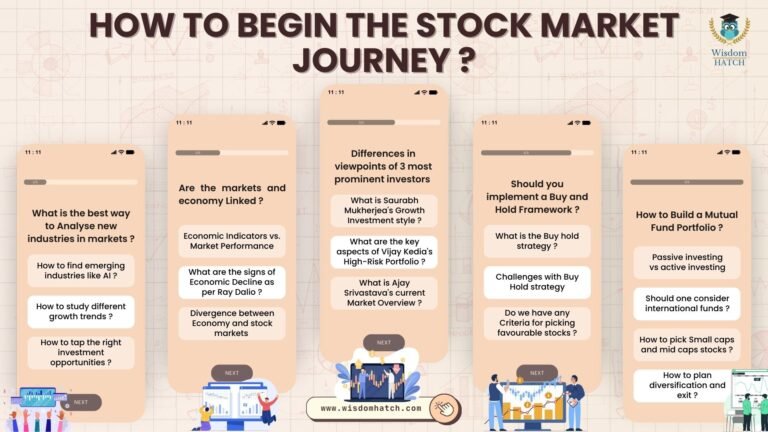
Most students at Harvard/INSEAD/IIMs would be great at Corporate Finance or Business Analysis. But, they would rarely invest in equity markets directly.
From my own experience of studying at INSEAD, I can tell you: that the business school taught me a lot about ‘analyzing’ business.
But, it did not teach me how to make money by investing well.
It is no surprise that less than 3% of Indians invest in stock markets. Lack of structured information is one of the primary reasons for this.
If you are starting your stock market journey. Or want to learn about it, here are 5 key commonly discussed points that we will be going through in this blog:
- How to build a Mutual Fund Portfolio?
- Buy and Hold Framework
- Are the Economy and Stock Markets linked?
- How to Analyze Industries?
- Understanding different market viewpoints.
[1] How to build a Mutual Fund portfolio.
My Strategy
I invest directly in stocks as an opportunistic and macroeconomic-oriented investor.
I only Invest in mutual funds when I find specific opportunities.
Passive vs. Active Investing:
Choose passive investing over active investing in mutual funds due to its lower expense ratio, limited fund manager discretion, and the ability to cut losses or book profits easily.
Lower expense ratios in passive funds make them more cost-effective and the lower exit loads means that you can book profits more easily.
Investing in International Funds:
You can choose to diversify your portfolio by investing in international funds to reduce geographic risk.
Avoid Investing in:
● Nifty Next 50:
- There’s no rational strategy for picking companies that move between the top 50 and top 100 ranks.
● Flexi Cap Funds:
- They often fail to outperform their benchmarks over time.
● Actively Managed Large Cap Funds:
- You are much better off directly investing in such large caps (the information is well known)
- As per the chart below, only 11% of Large Cap funds have beaten the benchmark over the last 5 years [1]
● Hybrid Funds
- Hybrid Funds are a max of both Debt and Equity.
- There are times when you should invest in both, but you should not mix your allocation
- Also since indexation benefits have been removed, you can directly invest your Debt money into Fixed Deposits.
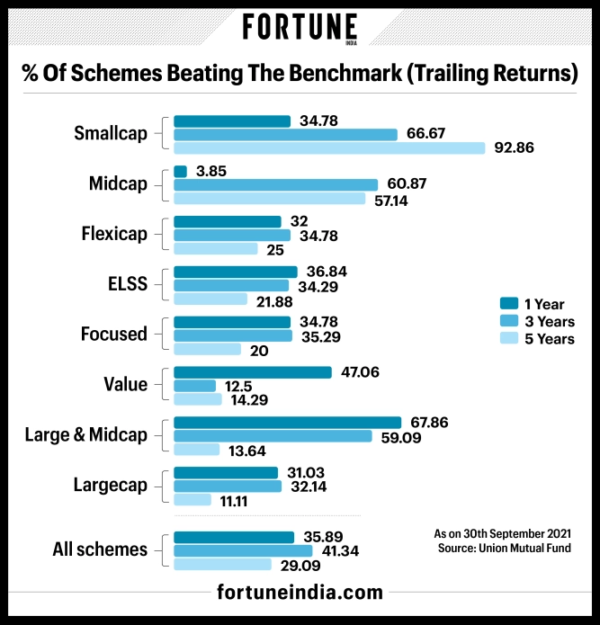
Small Cap and Mid Cap Funds:
You can choose to invest in actively managed funds when choosing to invest in small caps and mid caps.
It is relatively harder for retailers to pick out small cap or mid cap stocks directly, so it would make more sense for you to pick out such opportunities through Mutual Funds if you have good conviction on these types of stocks.
Also since these funds will give much higher returns, it’s ok to pay more in commissions.
You can do an SIP on these types of funds.
Diversification & Exit Strategy:
Always have a clear exit plan in mind, as per your market narrative.
Diversification is essential to spread risk and avoid concentration in any single fund. The speaker prefers not to rely on the performance of a single fund.
When choosing mutual funds, it’s important to consider how they fit into your overall investment portfolio and whether they complement your direct stock investments.
[2] We often look for BUY AND FORGET stocks:
But, honestly there are very few such stocks. And, there is a framework to understand what TRULY are buy and forget stocks:
The Buy and Hold Strategy:
Rakesh Jhunjhunwala’s success story with Titan exemplifies the potential of buy and hold investing, where he transformed a small investment into substantial wealth over time.
But if you take a deeper look at the Titan stock, there are multiple instances where the stock fell by more than 35-40% [2].
Similarly, there are long periods of no returns.
So this kind of behavior can cause a lot of panic and uneasiness among retailers who follow this technique.
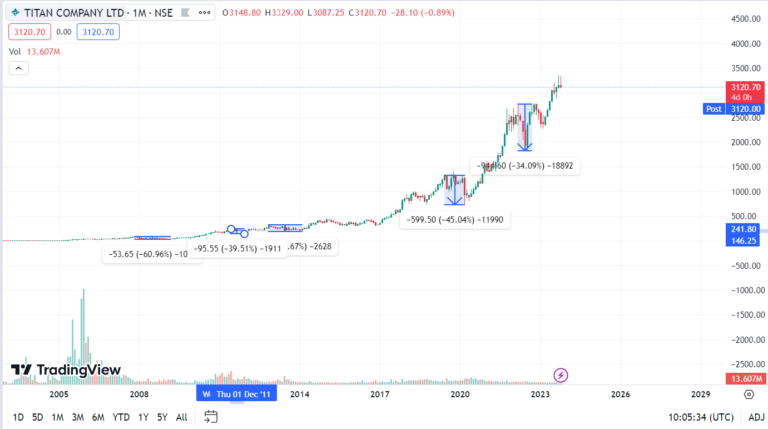
Challenges of Buy and Hold:
It’s essential to acknowledge that this strategy can be challenging due to the considerable price volatility that stocks can experience.
Criteria for Ideal Buy and Hold Stocks:
- Market Leadership: A company should dominate its market segment.
- Red Flag Absence: Companies with minimal negative news or controversies are preferred.
- Massive TAM: Total Addressable market should be high.
- Consistent Profit Generation: Stocks should exhibit a history of generating 15-20% annual profits.
- Valuation Consideration: Stocks should be purchased at reasonable valuations, and profit booking can provide a cushion against market downturns.
3 such stocks in my opinion are:
1. HDFC Bank
● They are a market leader in Private banks.
● Good management, No Red Flags
● They have a big TAM. Banking in India is just going to grow.
● Strong Macro Trends:
- India’s M1 Money Supply (Total Liquid money in the economy) has grown by 50% in the last 3 years [3].
- As this supply has increased, this will automatically reflect in the banks revenue and growth
● Strong Fundamentals
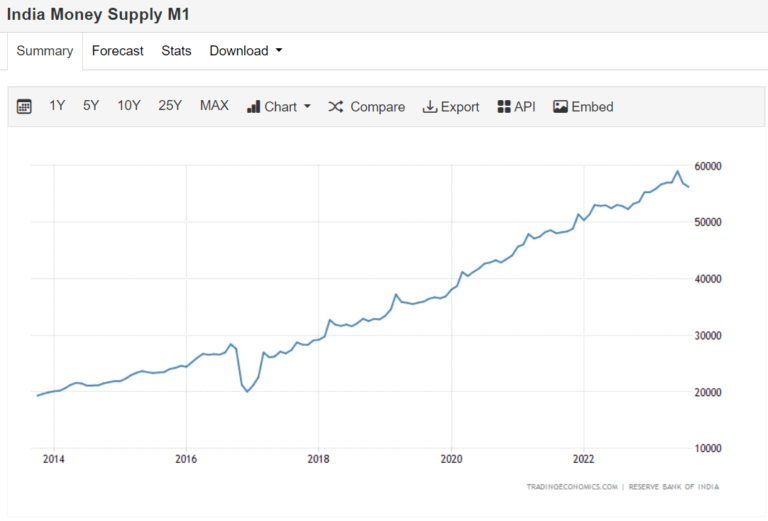
2. Apple
● They are a market leader.
● Their TAM is massive, and they focus on the rich population.
● No red flags, Massive Cash Positions.
● Strong Macro trends:
- They will continue growing as new technologies come by, and Apple has enough money to leverage all of it.
- They have massive purchasing power and are considered a luxury product.
3. Hindustan Unilever
● Again, they are market leaders
● They have consistently grown their profits, revenue and will continue to do so.
● They have a strong management.
● They have massive pricing power, they can pass on their costs to the consumer.
Remember, it’s good to book profits from time to time since this will increase your confidence to hold the stock, give you a cushion if the stock falls and give you a good Margin of Safety.
Approach stock investments strategically, consider undervalued stocks, and stay informed about market trends and conditions to make informed investment decisions.
If you are a new stock market investor or are looking for advanced techniques with a focus on better returns, check out this course on Stock Market Investing which covers all the aspects from Fundamental Analysis to key concepts like Macroeconomics and Wealth building.
[3] We often think that ECONOMY & Stock Markets are one and the same thing.
Well, it is not. Even in a good economy, stock markets can do badly and vice-versa.
Economic Indicators vs. Market Performance:
- The economy and stock markets are not the same thing.
- The economy refers to the overall health and performance of a nation, which includes factors like GDP, employment, inflation, and consumer spending.
- Stock markets, on the other hand, are financial markets where individuals and institutions buy and sell shares of publicly traded companies.
Signs of Economic Decline as per Ray Dalio:
- Interest rates falling to zero.
- Increased money printing or debt creation.
- Occurrence of financial crises.
- Rising wage gaps and income inequality.
- Internal and external disorder within the nation.
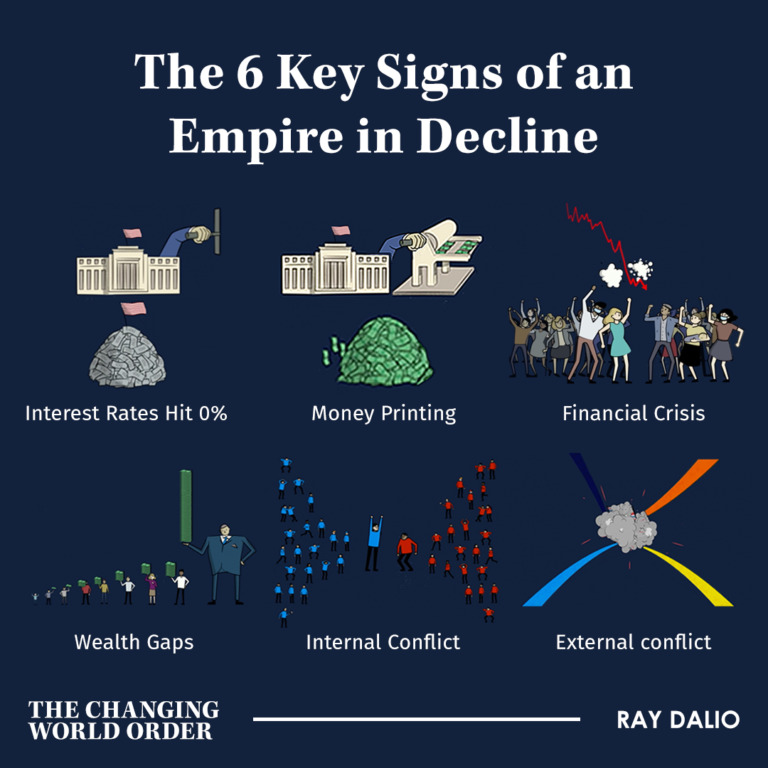
Examples of Economic Trends:
- Interest rates were near zero for several years after the 2008 financial crisis [5].
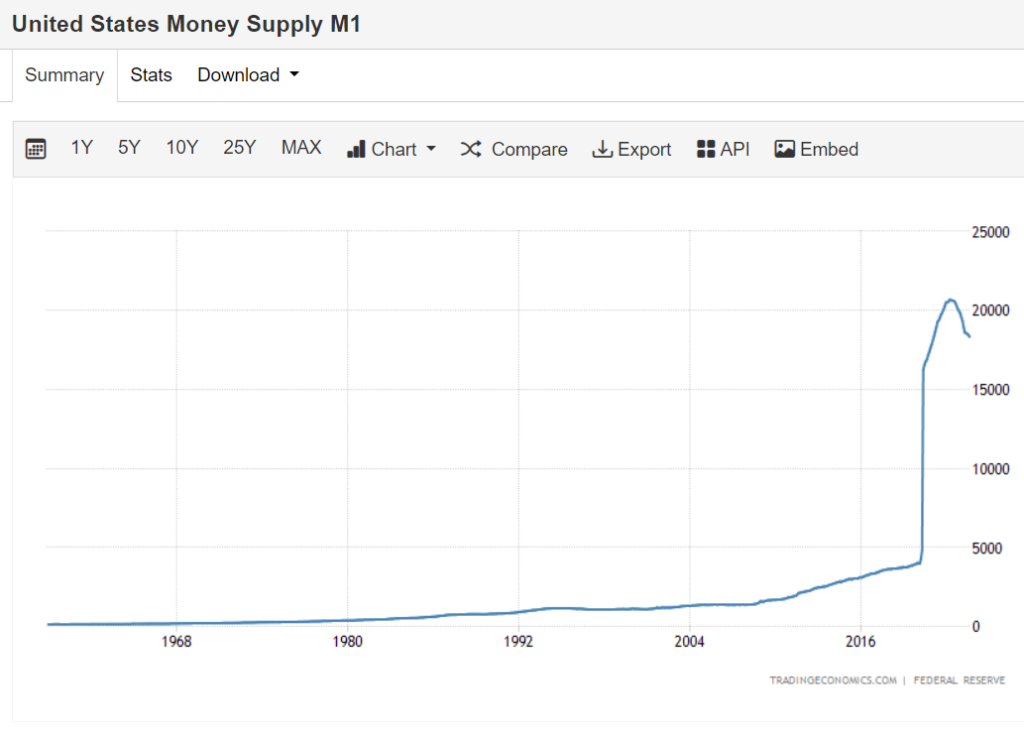
- A significant amount of money printing occurred after 2020 [6].
- Notable financial crises in 2008, 2020, and 2021/2022.
- Evidence of increasing wealth gaps over the decades [7].
- Observations of internal and external conflicts on social media platforms.
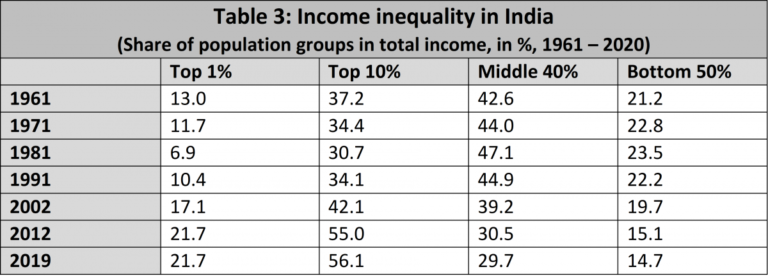
Global Economic Weakness:
- The world’s economy is fundamentally weakening.
- Even economies that were previously growing, like India, are stagnating.
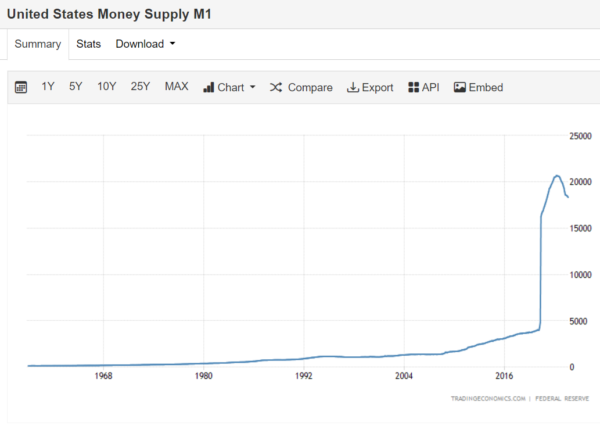
Economic Health and Stock Market Performance:
- While economic health can influence stock market performance, they do not always move in tandem.
- Economic indicators such as GDP growth, employment rates, and inflation can impact the stock market’s behavior.
- A robust economy can lead to increased corporate profits, which often correlates with rising stock market values.
Innovation and Productivity:
- Economic growth is linked to innovation and productivity.
- Major innovations historically accelerated growth (e.g., the internet).
- The world has seen less significant innovation in recent years.
- Real Productivity in the world has been falling [8].
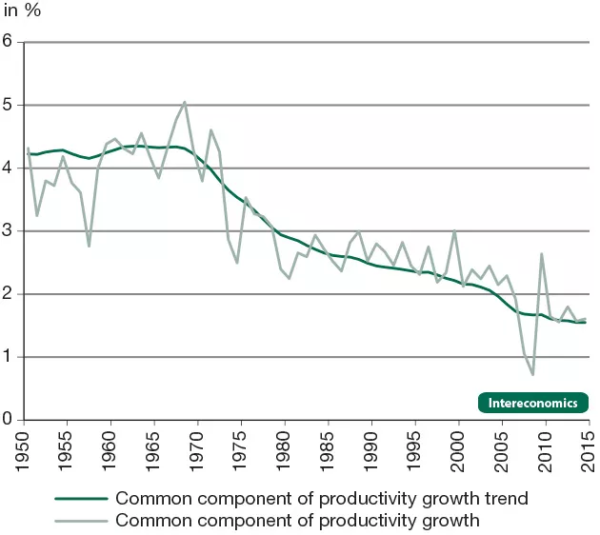
Excessive Debt Creation:
- Debt is a substantial part of the modern economy.
- Debt is often created when people deposit money in banks.
- Banks use these deposits to provide loans and invest in assets.
Divergence Between Economy and Stock Market:
- Consider investing in assets with limited supply, such as real estate or cryptocurrencies like Bitcoin.
● Favor short-term debt instruments over long-term ones in the current economic climate.
[4] How to analyze new industries:
Let’s do this exercise by picking out a new and upcoming industry: Artificial Intelligence.
1. AI Growth Trends:
- Begin by studying the growth trends of the AI industry.
- The global AI sector is expected to expand by approximately 21% [9[].
- Understanding the extent of growth and potential market size is essential for assessing the viability of the industry.
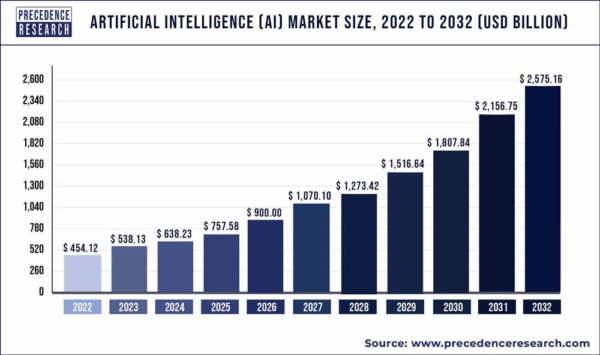
2. Investor Interest:
- Consider investor interest in the industry.
- Investors are increasingly looking to allocate funds to AI-based stocks and companies due to the transformative potential of AI in various sectors.
- This interest serves as an indicator of market confidence and can be a positive sign for new entrants.
3. Applications of AI:
- Analyze the specific applications of AI within the industry. AI can be categorized into data sets, software, hardware, commercial applications, and consulting.
- Identifying which of these areas are more prevalent in the industry and how AI is integrated can guide your analysis.
4. Data’s Crucial Role:
- Assess the importance of data sets and libraries within the industry.
- Quality data is crucial for training AI models and ensuring their accuracy, as exemplified by Google’s search engine. Evaluate how the industry utilizes and manages data.
5. Types of AI:
- Distinguish between weak and strong AI. Weak AI is specialized, while strong AI possesses cognitive abilities.
- Understanding the extent to which strong AI is applied in the industry can inform your analysis.
- Investigate the computational power required. Advancing from weak AI to strong AI necessitates substantial computational resources. Assess how well the industry is equipped in terms of hardware and processing capabilities.
7. Investment Opportunities in AI:
- Explore investment opportunities within the AI sector.
- Companies like NVIDIA and AMD are key players in AI hardware, while others like Super Micro Computer offer alternative investment options.
- Evaluate the potential for returns and risks associated with these opportunities.
8. AI Development Phases:
- Consider the development phases of AI in the industry.
- AI typically progresses from research and development (R&D) to commercialization and mainstream adoption.
- Assess where the industry currently stands in this progression.
- Big players with massive cash reserves like Apple, Amazon, Microsoft, Google, Meta etc. will all compete in this game.
9. Role of Indian IT Companies:
- Examine the role of Indian IT companies.
- While they may not be primarily involved in strong AI development, their potential role in cost-cutting and implementing AI solutions once AI becomes mainstream is worth evaluating.
[5] Understanding different market viewpoints.
I have spoken about 3 big investors from India, how they are analyzing the markets right now. And, what bets are they taking?
They are: Mr. Vijay Kedia, Mr. Saurabh Mukherjea, and Mr. Ajay Srivastava
Here are the key takeaways to better understand these different market viewpoints:
1. Diverse Investment Styles:
● Saurabh Mukherjea’s Growth Investing:
- Mukherjea adheres to a growth investment style, emphasizing fundamentally robust companies with growing ROCE and free cash flow.
- This approach can yield substantial returns but may be exposed to price volatility.
● Vijay Kedia’s High-Risk Portfolio:
- Kedia’s strategy is high-risk, high-reward.
- He play’s the VC game where he expects most of his investments will not work out, but the ones that do will yield exponential returns.
● Ajay Srivastava’s Market Overview:
- Srivastava provides a cautious perspective on the current market.
- He advises holding cash positions as a risk mitigation strategy.
2. Growth Investing Pros and Cons:
● Pros of Growth Investing:
- This strategy concentrates on clean companies showing growth in ROCE and free cash flow.
- It holds the potential for significant returns.
● Cons of Growth Investing:
- Growth stocks can be sensitive to market volatility and macroeconomic factors, making them susceptible to price fluctuations.
3. Stock Picks and Strategies:
● Saurabh Mukherjea’s Stock Picks:
- Mukherjea shares his insights into stocks he’s bullish on, including Metropolis Health, Divis Lab, Dr. Lal Path Lab, Titan, and Alkyl Amines.
- Some of these stocks are correlated.
● Vijay Kedia’s High-Risk Approach:
- Vijay Kedia’s portfolio includes an array of stocks, such as affordable robotics, Atul Auto, Patel Engineering, Precision, and Neuraland.
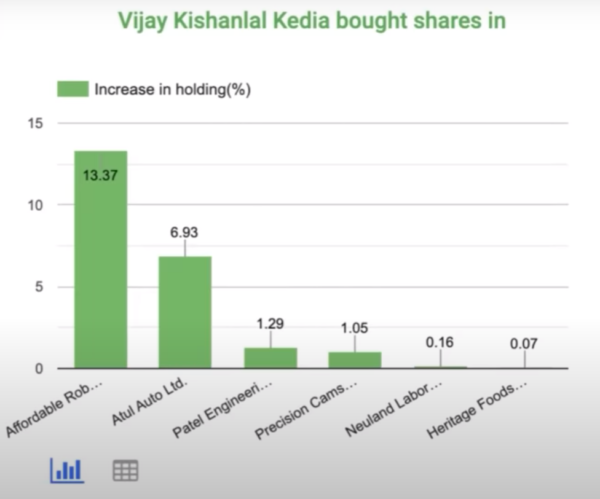
● Ajay Srivastava’s Sectoral Approach:
- Aja maintains a positive outlook on sectors like hotels, airlines, defense, infrastructure, and New Age companies.
- Conversely, he adopts a bearish stance on low-end retail, fertilizers, and commodities.
- However for a normal retailer this would be very concentrated and probably not the best idea.
- Since Mukerjea invests in growth stocks and focuses on long term buy and hold framework, he is most likely fully invested.
- He continues investing in stocks that he considers as growth stocks.
- His positive net worth demonstrates his confidence in the current market situation.
- He also seems to be fully invested in the market.
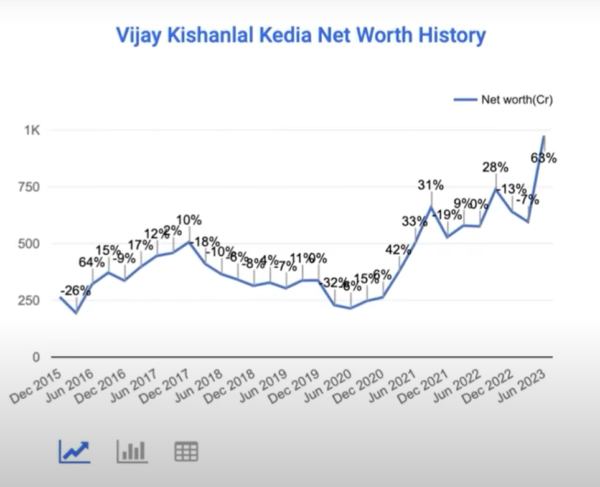
● Ajay Srivastava’s Cautious Stance:
- Srivastava’s cautious outlook underlines the importance of risk management in the current market.
By understanding these diverse market viewpoints, investors can gain valuable insights into various investment strategies, risk management techniques, and the advantages and disadvantages of growth investing.
This knowledge can be instrumental in making informed investment decisions and navigating the complexities of the financial markets.
Conclusion
In closing, as you embark on your stock market journey, remember that success in investing requires a multifaceted approach. These five key points shed light on important aspects often overlooked in traditional education. They emphasize the importance of strategy in building a mutual fund portfolio, understanding the nuances of buy and hold investing, recognizing the intriguing divergence between the economy and stock markets, exploring emerging industries, and gleaning insights from seasoned market experts.
By applying these principles and continuously educating yourself, you can embark on your investment journey with confidence and a well-rounded perspective, ultimately increasing your chances of achieving your financial goals.
- Blog highlights 5 key considerations for starting in the stock market.
- Topics include building a mutual fund portfolio and preferring passive over active investing.
- It advises on diversification and exit strategies for mutual funds.
- The blog discusses the buy and hold strategy, its challenges, and criteria for selecting such stocks.
- It differentiates between the economy and stock market performance, noting instances of divergence.
- The role of economic indicators, innovation, and debt creation in stock market behavior is explored.
- Tips for analyzing new industries like Artificial Intelligence are provided, covering growth trends, data’s importance, and investment opportunities.
- Diverse market viewpoints are presented, including growth investing, high-risk portfolios, and cautious market stances.
- Stock picks and strategies from noted investors are shared.
- The blog emphasizes the importance of understanding these viewpoints for informed investment decisions.
[1] https://www.fortuneindia.com/enterprise/70-actively-managed-mfs-underperform-should-you-exit/106201
[2] https://www.tradingview.com/chart/Jrj438JX/?symbol=NSE%3ATITAN
[3] https://tradingeconomics.com/india/money-supply-m1
[4]https://www.facebook.com/raydalio/photos/a.276710862750596/1404798426608495/?type=3&locale=ms_MY
[5] https://tradingeconomics.com/united-states/interest-rate
[6] https://tradingeconomics.com/united-states/money-supply-m1
[7] https://www.theindiaforum.in/article/does-india-have-inequality-problem
[8] https://www.intereconomics.eu/contents/year/2017/number/1/article/the-global-productivity-slowdown-diagnosis-causes-and-remedies.html
[9] https://www.precedenceresearch.com/artificial-intelligence-market
Ever wondered what we get in return for the taxes we pay in India. Whether the Tax Structure is TOXIC? Check out our Blog post on HEAVY TAXES, But we get NOTHING in return
MUST know BEFORE you become an Airbnb host
Medium Article Preksha Chand edit post MUST know BEFORE you become an Airbnb host Medium Article Preksha Chand edit post MUST know BEFORE you become an Airbnb host Medium...
Make more money from your property: Short-term rental [Airbnb]
Medium Article Preksha Chand edit post Make more money from your property: Short-term rental [Airbnb] Medium Article Preksha Chand edit post Make more money from your property: Short-term rental...
GOA Airbnb Laws: What Hosts Need to Know [2024]
Medium Article Preksha Chand edit post Make more money from your property: Short-term rental [Airbnb] Medium Article Preksha Chand edit post Make more money from your property: Short-term rental...





